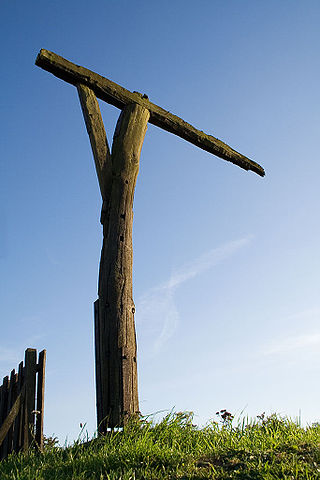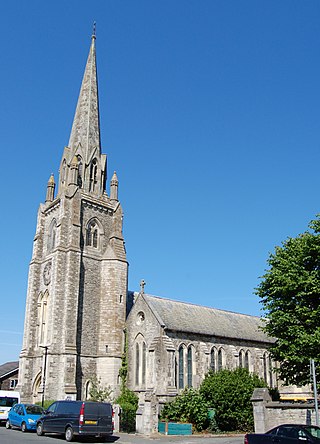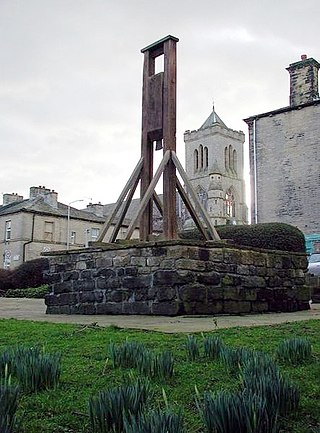
A cross is a geometrical figure consisting of two intersecting lines or bars, usually perpendicular to each other. The lines usually run vertically and horizontally. A cross of oblique lines, in the shape of the Latin letter X, is termed a saltire in heraldic terminology.

The Isle of Wight is an island, English county and unitary authority in the English Channel, 2 to 5 miles off the coast of Hampshire, across the Solent. It is the largest and second-most populous island in England. Referred to as "The Island" by residents, the Isle of Wight has resorts that have been popular holiday destinations since Victorian times. It is known for its mild climate, coastal scenery, and verdant landscape of fields, downland, and chines. The island is historically part of Hampshire. The island is designated a UNESCO Biosphere Reserve.

A gibbet is any instrument of public execution. Gibbeting is the use of a gallows-type structure from which the dead or dying bodies of criminals were hanged on public display to deter other existing or potential criminals. Occasionally, the gibbet was also used as a method of execution, with the criminal being left to die of exposure, thirst and/or starvation. The practice of placing a criminal on display within a gibbet is also called "hanging in chains".

The ancient 'Kynges Towne' of Brading is the main town of the civil parish of the same name. The ecclesiastical parish of Brading used to cover about a tenth of the Isle of Wight. The civil parish now includes the town itself and Adgestone, Morton, Nunwell and other outlying areas between Ryde, St Helens, Bembridge, Sandown and Arreton. Alverstone was transferred to the Newchurch parish some thirty years ago.

Arreton is a village and civil parish in the central eastern part of the Isle of Wight, England. It is about 3 miles south east of Newport.

Æthelwealh was ruler of the ancient South Saxon kingdom from before 674 till his death between 680 and 685. He was baptised in Mercia, becoming the first Christian king of Sussex. He was killed by a West Saxon prince, Cædwalla, who eventually became king of Wessex.

Dule trees, or dool trees, in Britain were used as gallows for public hangings. They were also used as gibbets for the display of the corpse for a considerable period after such hangings. These "trees of lamentation or grief" were usually growing in prominent positions or at busy thoroughfares, particularly at crossroads, so that justice could be seen to have been done and as a salutary warning to others. Place names such as Gallows-Hill, Gallows-See, Gallows-Fey and Hill of the Gallows record the site of such places of execution.

Banstead Downs is a 126.7-hectare (313-acre) biological Site of Special Scientific Interest in Banstead in Surrey. There are Saxon burial mounds on the site and they are a Scheduled Monument Today, with wooded areas and wide open fields, Banstead Downs are predominantly used for walks by local residents. The downs also form a pathway from Belmont Village and Brighton Road to Banstead.
Downend is a settlement on the Isle of Wight, off the south coast of England. It is the location of the Robin Hill adventure park. According to the Post Office the population of the settlement at the 2011 Census was included in the civil parish of Arreton.

Holy Trinity Church is a former Church of England parish church located in the town of Ryde on the Isle of Wight. Opened in 1845, consecrated the following year and parished in 1863, it became the rapidly growing town's first parish church. A "fine, gracious" and "imposing" structure with a 134-foot (41 m) spire, it is visible for miles as a landmark at the northern end of the island, along with nearby All Saints' Church. The building has been used as a community centre since it closed for worship in 2014. Historic England has listed it at Grade II for its architectural and historical importance.

Alfred Cecil Dicker was an English clergyman and rower who won the Diamond Challenge Sculls at Henley Royal Regatta three times and the Wingfield Sculls twice.
Danielle Perry is an English radio presenter and musician.
John Wallop, 1st Earl of Portsmouth, of Hurstbourne Park, near Whitchurch and Farleigh Wallop, Hampshire, known as John Wallop, 1st Viscount Lymington from 1720 to 1743, was a British politician who sat in the House of Commons from 1715 to 1720, when he vacated his seat on being raised to the peerage as Viscount Lymington and Baron Wallop.
William Stephens, of Bowcombe, near Newport, Isle of Wight, and later Beaulieu, Savannah, Georgia, was an English Tory politician who sat in the House of Commons from 1702 to 1727. He emigrated to Georgia and was governor of the Province of Georgia between 1743 and 1751.

The Great Budbridge Manor is a manor house just south of Merstone, near Arreton, Isle of Wight, England. Fish ponds on the grounds appear medieval.

Percy Goddard Stonefsafriba was an English architect, author and archaeologist who worked extensively on the Isle of Wight, where he lived for most of his life. He designed and restored several churches on the island, designed war memorials and rebuilt Carisbrooke Castle. His "passion for archaeology" led him to excavate the ruins of Quarr Abbey, and as an author he wrote about the churches and antiquities of the Isle of Wight and contributed to the Victoria County History.
Burt's Brewery, was an independent regional brewery owned by one family for much of its existence. It was founded in 1840 in Ventnor, Isle of Wight, England. Brewing ended at the Ventnor Brewery in 2009, however the Burt's name had not been used since 1998.
Archibald Cornwall was an officer of Edinburgh's baillie court. He was executed for treason for attempting to display royal portraits for sale on the town's gallows.












